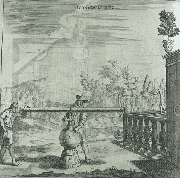|

Experiments
on the vacuum.
Otto von Guericke, Experimenta Nova (ut vocantur) Magdeburgica
De Vacuo Spatio, Amsterdam 1672
|
In a letter dated 1630,
Giovan Battista Baliani a patrician from
Genoa, asked Galileo for the reason why
water did not rise through the syphon he had made to carry water over
a hill about 21 metres high.
In his reply, Galileo claimed that nature's abhorrence of the void
did not entail a repugnance, and was not invincible - on the contrary,
it could be overcome with adequate force. Galileo had in fact ascertained
that the force of the vacuum was enough to lift a column of water
with a pump up to a maximum height of 18 'braccia' (around 11 metres)
Beyond this limit, the force of the vacuum was insufficient, and the
column of water disintegrated. This, according to Galileo, was why
Baliani's syphon couldn't work.
Even if he was unaware of the determining function of the weight of
air, the galileian interpretation of the void helped to get experimentation
going on the subject, and, above all, dispelled the conviction in
the absolute impossibility of generating a vacuum in nature.
|

